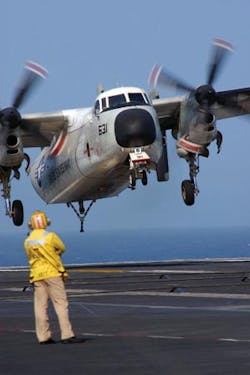The ability to balance a component such as a propeller when in operation, called active balancing, has been in development for several years. The Lord Corporation has been researching this technology that can enhance performance of rotating components. Two years ago, Lord partnered with Hamilton Sundstrand to offer an active balancing system for propellers called In-Flight Propeller Balancing (IFPB) to the aerospace industry. We will take a look at how this technology works and what it means for balancing propellers and other rotating components on aircraft.
Types of Unbalance
Out of balance propellers can not only be annoying to passengers and crew, they can be a source of damage to the aircraft. There are two types of unbalance — static and dynamic.
Static unbalance occurs when the center of gravity of the propeller does not coincide with the axis of rotation. To check for static unbalance, propellers are placed in a test stand. Any unbalance is noted and corrected according to the manufacturer’s instructions, usually by adding weights to the propeller cuff or bulkhead.
Dynamic unbalance is the unbalance that results when the center of gravity of the rotating propeller and components does not coincide with the axis of rotation. It is possible to have a propeller that is statically balanced but once it is on the aircraft it is dynamically out of balance. Many manufacturers recommend dynamic balancing of the propeller to increase comfort and reduce damage to the engine, airframe, and components.
Traditional Dynamic Balancing
There are several different types of dynamic balancing units available. They basically do the same thing. A sensor is mounted on the engine near the propeller. This sensor notes any imbalance present and gives the operator an indication of how excessive that imbalance is. If it is within limits, no further action is necessary. If it is out of limits, then the process of balancing the propeller begins.
We know that the propeller is dynamically out of balance, but we need to determine the location of the imbalance in order to correct it. The balancing units on the market have different ways of doing this. Some utilize a strobe light with a reflective marker on a blade. At the designated rpm, shooting the strobe toward the propeller will cause it to “freeze” allowing the mechanic to note the position of the target blade. The mechanic then uses a chart to determine weight correction needed and performs the process over again until the propeller is within balance limits. Other units utilize a sensor mounted on the engine facing the propeller to accomplish this same task. There are even units available that calculate everything for you and tell you where to add weight and how much to add.
Limits of Dynamic Balancing
Even though dynamic balancing is advantageous over static balancing, it does have its limits. The propeller is dynamically balanced at one specific operation condition. In other words it is balanced on the ground at a certain rpm. But the propeller balance can change during operation due to several factors including blade angle and aerodynamic loads. In addition, wear on the propeller blades also affects balance over time. Even though nothing can be done about the changes in balance conditions inflight, the changes in balance due to wear can be addressed through regular propeller balancing.
Active Balancing
Enter into the picture active balancing. Known as In-Flight Propeller Balancing (IFPB), this technology has the ability to constantly monitor propeller dynamic unbalance and apply necessary corrections immediately.
How it Works
The main components of the IFPB system are the accelerometer, controller, and balancing unit. There is one accelerometer mounted on each engine and one balancing unit installed on each propeller. There is one controller per aircraft installation.
The accelerometers monitor vibration levels and send their input to the controller. The controller constantly monitors input from all the accelerometers. If an unbalance is present, it signals the corresponding balancing unit to make a correction.
The balancing unit is mounted directly on the propeller. It is a ring with internal weights. The weights are shifted based on signals from the controller.
If for some reason a propeller is unable to be balanced by the balancing unit, the controller would send an indication to the crew allowing for the maintenance team to take corrective maintenance as needed.
Benefits
The obvious benefit to active balancing is that the propeller is constantly being monitored and balance is being corrected. This results in greater passenger comfort and less strain on the engine, airframe, and components. In addition, the time- consuming task of performing a dynamic balance can be eliminated.
The IFPB can significantly reduce vibration levels. According to Steve Meyer, Lord defense business development manager, based on earlier U.S. Navy NP2000 propeller ground tests, the IFPB system can be expected to reduce the average propeller vibration level during flight by a factor of five to 10 (to 0.05 ips) when compared to standard dynamic balancing. Meyer says that potential users of the IFPB system include USAF C-130 and the U.S. Navy P-3 and E-2C/C-2A.
Proven Technology
The active balancing system that has been developed by Lord Corporation leverages technology that has been proven in commercial applications. Electromechanical balancing technology has been in service in industrial applications for around a decade logging millions of hours of service in applications ranging from turbo-compressors to large extraction fans and high-speed machining spindles.
Drawbacks
If there is any drawback at this time, it is that this technology is not yet in service. But Lord continues to speak with the military and OEMs to develop applications that can benefit from IFPB technology. In the future, dynamic propeller balancing on the ground may be a thing of the past. Only time will tell. Stay tuned for more coverage of this emerging technology.





